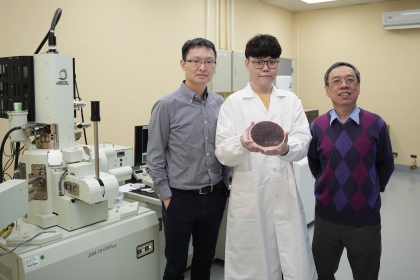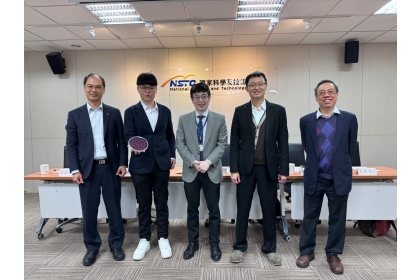Semiconductor Revolution! Discovering the Key to Functionality in Transistors and Memory Devices!
2024-01-15
興新聞張貼者
Unit秘書室
1,608
As technology rapidly advances, semiconductor technology faces unprecedented challenges. Supported by the National Science and Technology Council (NSTC), a collaborative research team led by Dr. Meng-Yu Tsai from the Institute of Electronics at National Tsing Hua University (NTHU), Professor Po-Wen Chiu, R&D Director of NTHU, Professor Yen-Fu Lin from the Department of Physics at National Chung Hsing University (NCHU), and Professor Jiunn-Lin Wu from the Department of Computer Science at NCHU, has made a significant breakthrough. They developed a novel dual-mode two-dimensional (2D) electronic component, transcending the physical limitations of traditional silicon wafers and paving new avenues for efficient computing and semiconductor process simplification. This notable achievement was published in the international journal Nature Electronics in September 2023.
The major advancement of this electronic component is its capability to seamlessly switch between "memory" and "transistor" modes. Light plays a pivotal role, acting as the "key" to trigger the device's functions. When illuminated, the component switches to "memory mode," dynamically adjusting its doping concentration and even charge polarity, akin to being "unlocked." In the absence of light, it stays "locked" in "transistor mode," maintaining stable switching functionality. This groundbreaking architecture brings to reality the feasibility of multifunctional mode switching in electronic components, offering a solution for processing and storing massive data in the next-generation computing.
The innovative structure of this component is built on a traditional silicon dioxide (SiO2) base, stacked with a van der Waals heterostructure. Key materials include a 2D ambipolar semiconductor (rhenium diselenide; ReSe2) and a 2D insulator (hexagonal boron nitride; h-BN). This arrangement allows light to induce the generation of numerous electron-hole pairs in ReSe2, channeling one type of charge carrier into the interface between h-BN and SiO2, thereby achieving polarity control and charge storage.
Furthermore, each mode of this component displays unique operational characteristics. In "transistor mode," it can be tailored for various N-type or P-type transistor configurations, enabling a spectrum of logic gate units from basic to complex. In "memory mode," it emulates synaptic functions of the human brain, especially potent when integrated with Convolutional Neural Networks (CNNs) for image recognition, enhancing the ability to process complex visual tasks. This illustrates its potential in neuromorphic computing and opens new directions in artificial intelligence technology.
In today's data-intensive and highly integrated digital era, the dual-mode operational 2D electronic component developed by the joint team from NTHU and NCHU marks a significant breakthrough in semiconductor technology. This light-controlled electronic component, capable of flexibly switching between memory and transistor modes, holds immense potential for next-generation integrated circuit design and neural network applications. Future prospects include large-scale array applications in semiconductor manufacturing, simplifying processes, enhancing efficiency, and potentially overcoming the bottleneck of von Neumann architecture caused by miniaturization in semiconductor technology.
Article source: https://www.nature.com/articles/s41928-023-01034-7
The major advancement of this electronic component is its capability to seamlessly switch between "memory" and "transistor" modes. Light plays a pivotal role, acting as the "key" to trigger the device's functions. When illuminated, the component switches to "memory mode," dynamically adjusting its doping concentration and even charge polarity, akin to being "unlocked." In the absence of light, it stays "locked" in "transistor mode," maintaining stable switching functionality. This groundbreaking architecture brings to reality the feasibility of multifunctional mode switching in electronic components, offering a solution for processing and storing massive data in the next-generation computing.
The innovative structure of this component is built on a traditional silicon dioxide (SiO2) base, stacked with a van der Waals heterostructure. Key materials include a 2D ambipolar semiconductor (rhenium diselenide; ReSe2) and a 2D insulator (hexagonal boron nitride; h-BN). This arrangement allows light to induce the generation of numerous electron-hole pairs in ReSe2, channeling one type of charge carrier into the interface between h-BN and SiO2, thereby achieving polarity control and charge storage.
Furthermore, each mode of this component displays unique operational characteristics. In "transistor mode," it can be tailored for various N-type or P-type transistor configurations, enabling a spectrum of logic gate units from basic to complex. In "memory mode," it emulates synaptic functions of the human brain, especially potent when integrated with Convolutional Neural Networks (CNNs) for image recognition, enhancing the ability to process complex visual tasks. This illustrates its potential in neuromorphic computing and opens new directions in artificial intelligence technology.
In today's data-intensive and highly integrated digital era, the dual-mode operational 2D electronic component developed by the joint team from NTHU and NCHU marks a significant breakthrough in semiconductor technology. This light-controlled electronic component, capable of flexibly switching between memory and transistor modes, holds immense potential for next-generation integrated circuit design and neural network applications. Future prospects include large-scale array applications in semiconductor manufacturing, simplifying processes, enhancing efficiency, and potentially overcoming the bottleneck of von Neumann architecture caused by miniaturization in semiconductor technology.
Article source: https://www.nature.com/articles/s41928-023-01034-7



